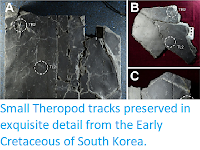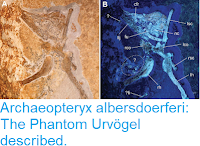The Coelurosaurs were a diverse group of Therapod Dinosaurs, including
the Tyrannosaurs, Compsognathids, Ornithomimids and Maniraptors (the
group that includes the modern Birds). They are thought to have appeared
and diversified in the Mid-to-Late Jurassic, though fossils from this
early are rare, and usually fragmentary, often comprising only isolated
teeth. The Megaraptors are a poorly understood group of Theropod Dinosaurs, currently thought to be basal members of the Coelurosauria (i.e. they are an early group that diverged from the main Coelurosaur lineange before the appearance of Tyrannosaurs and Maniraptors. They appear to have been medium sized Theropods with long claws, broad bodies and highly pneumatised skeletons, though they are known only from incomplete skeletons, making their true nature and affinities hard to judge.
In a paper published in the journal Acta Palaeontologica Polonica on 27 May 2019, Adun Samathi of the Division of Paleontology at the Rheinische Friedrich-Wilhelms Universität Bonn, Phornphen Chanthasit of the Sirindhorn Museum, and Martin Sander, also of the Division of Paleontology at the Rheinische Friedrich-Wilhelms Universität Bonn, describe two new species of Coelurosaurs from the Early Cretaceous Sao Khua Formation of northeastern Thailand, one of which is considered to be a Megaraptor, and one of which could possibly be.
The first Dinosaur bones discovered in Thailand cane from the red clays of the Sao Khua Formation on Phu Wiang Mountain in the 1970s and 80s, since when the site has been extensively worked, producing a range of fossils including Ornithischians, Sauropods, and Theropods, as well as freshwater Hybodont Sharks, Actinopterygian Fish, Turtles, and Crocodilians. These deposits were originally thought to be Jurassic in age, but are now considered to be Early Cretaceous.
The first new species described is named Phuwiangvenator yaemniyomi, where 'Phuwiangvenator' derives from Phu Wiang Mountain in Khon Kaen Province, Thailand, where the specimen was found, plus '-venator' Latin for 'hunter', making 'hunter of Phu Wiang', and 'yaemniyomi' honours Sudham Yaemniyom, the geologist who found the first ever Dinosaur bone on Phu Wiang Mountain in 1976. The specimen comprises a disarticulated partial skeleton consisting of a dorsal vertebra, three fused sacral vertebrae, the right second metacarpal, plus the right phalanges and unguals, both tibias, the left left astragalocalcaneum, the left first metatarsal, the right second to fourth metatarsals, and the right pedal phalanges and unguals. This specimen is reconstructed as a Megaraptor about 6 m in length.
Coelurosaurian Theropod Phuwiangvenator yaemniyomi from the Early Cretaceous Sao Khua Formation of Phu Wiang, Khon Kaen Province, Thailand. (A) Right tibia in anterior (A₁), lateral (A₂), posterior (A₃), medial (A₄), proximal (A₅), and distal (A₆) views. (B) Proximal left tibia in lateral view. Arrow indicates vertical ridge on the tibia. Samathi et al. (2019).
The second new species is named Vayuraptor nongbualamphuensis, where 'Vayuraptor' derives from 'Voyu' Sanskrit for the God of Wind and '-raptor', to give 'wind-raptor', in reference to the long, slim tibia of the specimen, which suggests a fast running animal. The species is described from the tibia mentioned, plus some coracoids, a fragment of fibula, a rib, a probable fragment of the pubis, a manual phalanx, and a probable pedal phalanx. It is interpreted as a small Theropod 4-4.5 m in length, with body proportions similar to those of the Magaraptor Fukuiraptor kitadaniensis.
Coelurosaurian Theropod Vayuraptor nongbualamphuensis from the Early Cretaceous Sao Khua Formation of Phu Wat, Nong Bua Lamphu Province, Thailand. Left tibia with associated astragalocalcaneum in anterior (A₁), lateral (A₂), posterior (A₃), medial (A₄), proximal (A₅), and distal (A₆) view. Arrow indicates vertical ridge on the tibia. Samathi et al. (2019).
See also...
Follow Sciency Thoughts on
Facebook.








